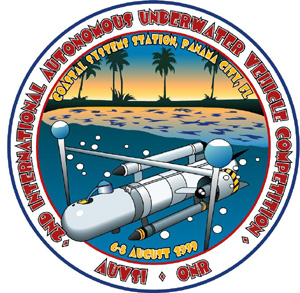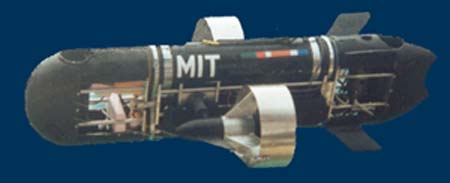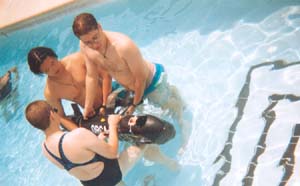MIT Wins The 1999 AUVSI AUV Competition
Mission
 The
International Autonomous Underwater Vehicle Competition
challenges teams of college students to
design and build underwater vehicles to navigate a submerged obstacle course.
While operating autonomously under computer control, vehicles must pass through
a series of gates, then enter a specified recovery zone, drop a marker, and
surface, all within a specified time interval.
The
International Autonomous Underwater Vehicle Competition
challenges teams of college students to
design and build underwater vehicles to navigate a submerged obstacle course.
While operating autonomously under computer control, vehicles must pass through
a series of gates, then enter a specified recovery zone, drop a marker, and
surface, all within a specified time interval.
The contest arena for the AUVSI competition is the P-253 test pond at the
Naval Coastal Systems Station
in Florida. Six gates, with two uprights and a crossbar made of PVC pipe, are submerged
along the perimeter of the pond, on the 3 m depth contour. From the sixth gate, a submerged pipeline will
lead to the target zone, a 3 m square underwater raised platform. Each team's fully autonomous underwater
vehicle must pass between the uprights and under the crossbar of each gate, follow the pipeline, enter the
target zone, release a marker, and surface in the target zone in under 20 minutes.
 The vehicle is not permitted to communicate with any off-board entity, including navigation beacons and
the Global Positioning System. Points are awarded for each gate traversed, for marking the maximum depth
in the target zone, for surfacing in the target zone, and for time.;
The vehicle is not permitted to communicate with any off-board entity, including navigation beacons and
the Global Positioning System. Points are awarded for each gate traversed, for marking the maximum depth
in the target zone, for surfacing in the target zone, and for time.;
Competition Weekend
Teams arrived at the P-253 Test Pond an the Coastal Systems
Station on Friday, August 6 for the 1999 competition. The weather was hot and
sunny. Friday afternoon was given over to vehicle testing in the competition
arena. The team set to work perfecting the isobath-following code that was used
to navigate through the six gates. While some team members worked on the isobath
code, others attempted to interface to a mechanical scanning sonar unit which we
hoped to use to locate the gates. While the vehicle was capable of following the
isobath at low speed, it tended to pitch out of control at high speed.
At 1800 hours the test pond closed and we retreated to our motel pool to develop an
active pitch control system using the vertical thrusters mounted fore and aft.
 Saturday saw more testing at the P-253 test pond. Overnight we had perfected
a pitch control system and a safety system to slow the vehicle if its depth
deviated from our command. With these changes the vehicle was able to navigate
the perimeter of the test pond in under 10 minutes. At that point we turned our
attention to the final competition task, the location and marking of a submerged
target zone. Hampered by the limited range of our sonar altimeter, we left the
test pond Saturday without a successful target zone acquisition program.
Saturday saw more testing at the P-253 test pond. Overnight we had perfected
a pitch control system and a safety system to slow the vehicle if its depth
deviated from our command. With these changes the vehicle was able to navigate
the perimeter of the test pond in under 10 minutes. At that point we turned our
attention to the final competition task, the location and marking of a submerged
target zone. Hampered by the limited range of our sonar altimeter, we left the
test pond Saturday without a successful target zone acquisition program.
Saturday night we settled upon a strategy for navigating to the deeper
isobath of the target zone, and in the motel pool
we discovered that our altimeter was capable of detecting the edge of the
target zone. By the end of the evening we had an untested program for
finding and marking the target zone, and we planned to use our one hour of
alloted testing time for debugging. Despite the imminence of the
competition we felt we had a good chance of completing the competition mission.
Sunday dawned rainy with electrical storms passing over head
periodically. The competition day testing runs were delayed first for an
hour, then for another two. When we got to the arena, each team's test
time had been cut from one hour to only 40 minutes. Almost as soon as we
got in the pool the sky darkened and thunder rumbled in the distance.
After only a few minutes of testing, the competition officials pulled us
out of the water as an electrical storm passed overhead. Remaining test
time was cancelled, and the competition began immediately with the passing
of the storm.
When MIT's turn came up, the University of Florida's vehicle had just put in
an impressive performance, passing through four of the six gates on the pond's
perimeter after a couple of false starts. ORCA-2 had to make it through at least
five gates to ensure victory. Although we had demonstrated the ability to pass
through all six gates at 40% of full power, we chose to reduce our speed to make
the vehicle track straighter. At the prompting of the competition officials, we
rolled ORCA-2 to the edge of the P-253 test pond and set up our wireless
communication system. Matt logged into the vehicle and checked some last-minute
parameters. At our command, ORCA-2 was lowered into the test pond, the lift rope
was cast off, and Matt commanded the vehicle to start it's autonomous mission.
Like magic, ORCA-2 submerged to 1 meter depth, headed for the center of the
pond, then turned back toward the shore, turning sharply to the right as it
aquired the 3 meter isobath. With two divers from the Navy Experimental Dive
Unit in hot pursuit, ORCA-2 passed through the first gate and headed for the
second. Slowly but surely, our vehicle passed through all six gates, returning
to the launch site for recovery by the divers. Project ORCA had triumphed again.
|


 Copyright 1998-2009 MIT.
Copyright 1998-2009 MIT.
 The
The
 The vehicle is not permitted to communicate with any off-board entity, including navigation beacons and
the Global Positioning System. Points are awarded for each gate traversed, for marking the maximum depth
in the target zone, for surfacing in the target zone, and for time.;
The vehicle is not permitted to communicate with any off-board entity, including navigation beacons and
the Global Positioning System. Points are awarded for each gate traversed, for marking the maximum depth
in the target zone, for surfacing in the target zone, and for time.;  Saturday saw more testing at the P-253 test pond. Overnight we had perfected
a pitch control system and a safety system to slow the vehicle if its depth
deviated from our command. With these changes the vehicle was able to navigate
the perimeter of the test pond in under 10 minutes. At that point we turned our
attention to the final competition task, the location and marking of a submerged
target zone. Hampered by the limited range of our sonar altimeter, we left the
test pond Saturday without a successful target zone acquisition program.
Saturday saw more testing at the P-253 test pond. Overnight we had perfected
a pitch control system and a safety system to slow the vehicle if its depth
deviated from our command. With these changes the vehicle was able to navigate
the perimeter of the test pond in under 10 minutes. At that point we turned our
attention to the final competition task, the location and marking of a submerged
target zone. Hampered by the limited range of our sonar altimeter, we left the
test pond Saturday without a successful target zone acquisition program.